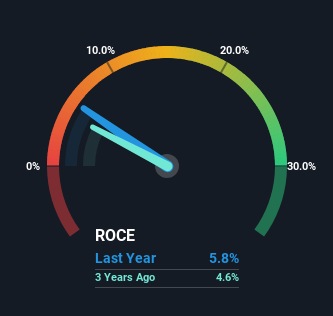- India
- /
- Metals and Mining
- /
- NSEI:MAHASTEEL
Here's What's Concerning About Mahamaya Steel Industries' (NSE:MAHASTEEL) Returns On Capital

When researching a stock for investment, what can tell us that the company is in decline? When we see a declining return on capital employed (ROCE) in conjunction with a declining base of capital employed, that's often how a mature business shows signs of aging. This combination can tell you that not only is the company investing less, it's earning less on what it does invest. In light of that, from a first glance at Mahamaya Steel Industries (NSE:MAHASTEEL), we've spotted some signs that it could be struggling, so let's investigate.
Return On Capital Employed (ROCE): What Is It?
For those that aren't sure what ROCE is, it measures the amount of pre-tax profits a company can generate from the capital employed in its business. To calculate this metric for Mahamaya Steel Industries, this is the formula:
Return on Capital Employed = Earnings Before Interest and Tax (EBIT) ÷ (Total Assets - Current Liabilities)
0.058 = ₹96m ÷ (₹2.2b - ₹596m) (Based on the trailing twelve months to June 2023).
Therefore, Mahamaya Steel Industries has an ROCE of 5.8%. Ultimately, that's a low return and it under-performs the Metals and Mining industry average of 15%.
View our latest analysis for Mahamaya Steel Industries

While the past is not representative of the future, it can be helpful to know how a company has performed historically, which is why we have this chart above. If you'd like to look at how Mahamaya Steel Industries has performed in the past in other metrics, you can view this free graph of past earnings, revenue and cash flow.
What Can We Tell From Mahamaya Steel Industries' ROCE Trend?
There is reason to be cautious about Mahamaya Steel Industries, given the returns are trending downwards. To be more specific, the ROCE was 11% five years ago, but since then it has dropped noticeably. And on the capital employed front, the business is utilizing roughly the same amount of capital as it was back then. This combination can be indicative of a mature business that still has areas to deploy capital, but the returns received aren't as high due potentially to new competition or smaller margins. If these trends continue, we wouldn't expect Mahamaya Steel Industries to turn into a multi-bagger.
On a related note, Mahamaya Steel Industries has decreased its current liabilities to 26% of total assets. So we could link some of this to the decrease in ROCE. Effectively this means their suppliers or short-term creditors are funding less of the business, which reduces some elements of risk. Since the business is basically funding more of its operations with it's own money, you could argue this has made the business less efficient at generating ROCE.
In Conclusion...
In the end, the trend of lower returns on the same amount of capital isn't typically an indication that we're looking at a growth stock. Investors must expect better things on the horizon though because the stock has risen 4.8% in the last five years. Regardless, we don't like the trends as they are and if they persist, we think you might find better investments elsewhere.
Mahamaya Steel Industries does have some risks though, and we've spotted 1 warning sign for Mahamaya Steel Industries that you might be interested in.
While Mahamaya Steel Industries isn't earning the highest return, check out this free list of companies that are earning high returns on equity with solid balance sheets.
New: Manage All Your Stock Portfolios in One Place
We've created the ultimate portfolio companion for stock investors, and it's free.
• Connect an unlimited number of Portfolios and see your total in one currency
• Be alerted to new Warning Signs or Risks via email or mobile
• Track the Fair Value of your stocks
Have feedback on this article? Concerned about the content? Get in touch with us directly. Alternatively, email editorial-team (at) simplywallst.com.
This article by Simply Wall St is general in nature. We provide commentary based on historical data and analyst forecasts only using an unbiased methodology and our articles are not intended to be financial advice. It does not constitute a recommendation to buy or sell any stock, and does not take account of your objectives, or your financial situation. We aim to bring you long-term focused analysis driven by fundamental data. Note that our analysis may not factor in the latest price-sensitive company announcements or qualitative material. Simply Wall St has no position in any stocks mentioned.
About NSEI:MAHASTEEL
Mahamaya Steel Industries
Engages in the manufacture and sale of structural steel products in India.
Proven track record with adequate balance sheet.
Similar Companies
Market Insights
Community Narratives



